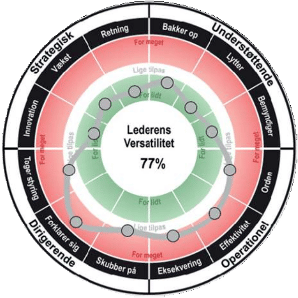Strengths-based leadership - what does it take to develop strengths-based leadership for the complex challenges of modern organizations?
Peter Drucker put the "maggitation" of his life's work with strategy and leadership this way: "The task of leadership is to bring together our strengths so that our weaknesses become irrelevant". But can this really be true? What happens when our leaders rely on strengths alone?
This article suggests how the next generation of strengths-based leadership should be formulated in order for a strengths-based approach to really become a lever for developing effective leaders who can improve both well-being and productivity. The article challenges the narrow focus of classic strengths-based thinking on strengths and weaknesses. A well-kept secret is that overplayed strengths are just as much a source of inefficiency and dissatisfaction as weaknesses are. The ambition of this article is to offer managers and HR a nuanced view of the fact that "what it takes" to develop effective leaders and organizations is the research-based experience that effective leaders both address their weaknesses, cultivate their strengths and are able to reduce their exaggerated strengths (Kaplan & Kaiser, 2006).
Why strengths-based leadership
Without a strengths-based approach to leadership, it's easy to over-focus on weaknesses. Just think of the front page of Ekstrabladet. This often comes at the expense of knowing our strengths - what we do best, where we are most creative and competent. In response to a one-sided weakness-focused leadership development, strengths-based leadership has undoubtedly moved development work in a productive and energizing direction. The message of strengths-based leadership is that as a leader, you need to know and manage your strengths and weaknesses. But as Drucker puts it, this should be done by cultivating your strengths so that your weaknesses become insignificant.
Why is this a problem? It's because "strengths fanatics" overlook, and train leaders to overlook, that leadership behavior is not only made up of strengths and weaknesses, but just as much of overplayed and thus ineffective strengths (Kaplan & Kaiser, 2006).
Working with strengths in organizations where the dominant development culture is based on troubleshooting and correction can demonstrably improve employee performance and well-being. Leaders and employees who are aware of their strengths are more likely to be able to use them proactively (Kaplan & Kaiser, 2006). However, a one-sided focus on strengths is likely to bring less wellbeing, engagement and performance than a balanced approach that embraces both the positive and the negative - i.e. strengths, overplayed strengths and weaknesses. Research shows that the negative, in the form of negative emotions, is crucial for motivation, creativity and well-being (Rego et al., 2012; Fredrickson, 2013), while managing unrealized strengths and developing a balanced leadership style - so-called versatile leadership - can account for 50% of what separates the most effective leaders from the least effective leaders on the parameters of well-being, productivity and overall leadership effectiveness (Kaplan & Kaiser, 2006; Sørensen & Grøn, 2015).
Too much of a good thing
The next generation of strengths-based management must therefore be complemented by the simple realization that too much of a good thing can be a real problem. Just because broccoli is healthy doesn't mean that it's healthy to live on broccoli alone, just as being detail-oriented is good, but micro-management doesn't necessarily promote well-being or production. But who is affected by "too much of a good thing" and how do we develop better leaders?

Even a strong leader is not immune to overplaying their strengths. In fact, the risk of overstating strengths increases with the strength of the strength, as does the likelihood of being unaware that one's strengths can be taken too far (Kaplan & Kaiser, 2013). The strengths movement invites managers and HR to imagine that it's possible to highlight strengths and pigeonhole weaknesses. However, the reality is that you can't simply ignore your weaknesses, as they are often inextricably linked to your strengths. The inconvenient truth for strengths advocates is that weaknesses are often by-products of strengths. Too directive leadership makes employees passive - and ineffective. Too supportive leadership provides too little direction - and leaves employees at a loss. Effective leadership is a balancing act between opposing leadership focuses. Becoming a better leader is not about playing up your strengths and hoping that weaknesses become insignificant, but rather about constantly adapting the volume of strengths to the given situation (Kaplan & Kaiser, 2013).
READ MORE ABOUT OUR EDUCATION
LEAD
offers certification in the development of agile leadership with the development tool The Leader's Versatility Index (LVI)
With a certification, you will be equipped to use LVI in development processes in your organization at the individual, group and organizational level.
Derailment - The strengths-based leader doesn't exist
The problem is that the strengths-based approach ignores what we know about why leaders derail and get derailed in their careers (Kaiser, 2009). The strengths that are valued in leaders by employees, such as a strong operational, professional and directive leadership style with control over production, become strong derailment factors the higher the leader climbs in the hierarchy - in the organization's leadership pipeline. The operational and professional strengths become micro-management and bypass the ability of professional employees to contribute with qualified input - just as directive leadership, which is a virtue at the operational level, is perceived as self-promotion, poor parenting and rigidity at the higher management levels. Here, strong cross-functional collaboration skills and strategic leadership are necessary strengths to develop in order to work effectively (Dahl & Molly Søholm, 2013).
The number one reason why top leaders derail is relationship issues. Even the best strategist cannot delegate the task of creating and maintaining good relationships in the organizational landscape, which would be the simple strengths-based approach's answer to the "staff around" problem - we hire our way out of it (Kai- ser, 2009). The leader needs to develop their relationship skills in the balance between supportive and directive leadership behaviors, while also being a strong strategist with a handle on day-to-day operations. Otherwise, things can easily go wrong.
The Center for Creative Leadership, which has studied leadership derailment for more than two decades, has found that the most common cause of derailment can be traced back to a weakness (Kaiser & White, 2008). Thus, encouraging leaders to unilaterally maximize their strengths - often at the expense of equally necessary complementary strengths (Kaiser, 2006) - is inadvertently encouraging them to overuse and misuse their strengths. The bottom line is that there is no such thing as a unilateral strengths-based leader. In an increasingly complex age of talent scarcity and concerns about employee engagement and retention, it's no wonder we're keen to embrace an approach that deals with the positive and the strong. But this is a risky strategy, as increasing complexity calls for leaders who are able to manage and operate in complex conditions - and having a limited repertoire of strengths is not enough. It is intuitively more likely, and there is research evidence that a versatile, multi-faceted and balanced approach to learning and development will create the leaders we so desperately need in these uncertain and volatile times (Kaiser, 2009).
Therefore, it's also time to move away from the simple strengths-based leadership approach and add "what it takes" - a nuanced understanding that leadership behaviors must be developed within a framework of understanding where behaviors are made up of weaknesses, strengths and exaggerated strengths, and that effective leaders develop strengths within opposing but complementary leadership styles - what Kaplan and Kaiser call versatile leadership.
The next generation of strengths-based leadership must be supplemented with knowledge, concepts and methods to work with effective leaders being versatile leaders - i.e. leaders with a broad perspective and large counter-directional leadership repertoire that enables them to handle a whole range of complex challenges such as increased globalization and speed.
References
- Dahl, K. & Molly-Søholm, T. (2013). Leadership Pipeline in the public sector. Danish Psychological Publishing House.
- Fredrickson, B.L. (2013). Positivity: Sources of Growth, Danish Psychological Publishing House, Copenhagen.
- Kaiser, R.B. (2009). Too Good to Be True - Are strengths all leaders need, Chief Learning Officer.
- Kaplan, R.B. & Kaiser, R.B. (2006). The Versatile Leader: Make the Most of Your Strengths Without Overdoing It", Pfeiffer.
- Kaplan, R.E. & Kaiser, R.B. (2013). What Is Lost in Finding Your Strengths, Leadership Excellence, Vol. 30, No. 5.
- Rego, A., Sousa, F., Marques, C. & Cunha, M.P.E. (2012). Optimism predicting employees´ creativity:
The mediating role of positive affect and the positivity ratio, European Journal of Work and Organizational Psychology, 21:2.
- Sørensen, N.H. & Grøn, R.T. (2015). "Versatile leadership - how leaders achieve effect in a VUCA world", Børsen.



